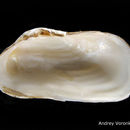fi
nimet breadcrumb-navigoinnissa


“Saxicava arctica, Linné, 1767. Plate 55, figs. 6, a.
Shell small, polymorphous, inequilateral, usually oblong, very rugose, thin, sometimes fragile, young specimens very often with posterior spinous ridges, white or light brown. Beaks approximate, slightly raised, tumid, tricarinate, 1 anterior and 2 posterior, incurved and acute. Anterior end much shorter, usually truncated or convex and very rapidly descending; posterior end frequently very long, truncated or convex; the basal margin broadly convex or more or less deeply sinuated. Epidermis thin, dull, brown. Sculpture consisting of very irregular, concentric, sharply raised, often anastomosing riblets, crowded in front, distant and rather lamellar posteriorly; 2 sharp ridges are descending on each valve from the umbones towards the posterior end, and in young specimens are usually ornamented with small tubular spines. Colour light brown or nearly white. Interior white, slightly shining, smooth. Hinge very narrow; right valve with an oblique small tooth below and just in front of the umbo, and a socket behind it; left valve with a small, conical, upturned tooth a little behind the beak. Ligament external, short, rather prominent. Adductor-scars unequal, the posterior larger. Pallial sinus shallow.
Dimensions extremely variable, the greatest length of shells I have seen being 17 mm.
Hab. – Throughout New Zealand, Chatham, Auckland, and Kermadec Islands.
The species is apparently distributed all over the globe, and is found from low-water mark to about 500 fathoms.
Fossil in the Pliocene.”
(Suter, 1913)